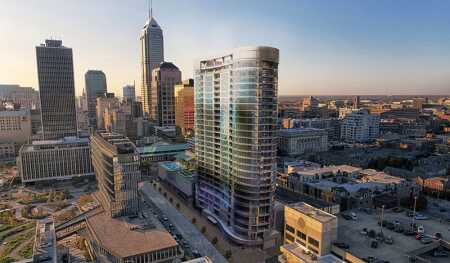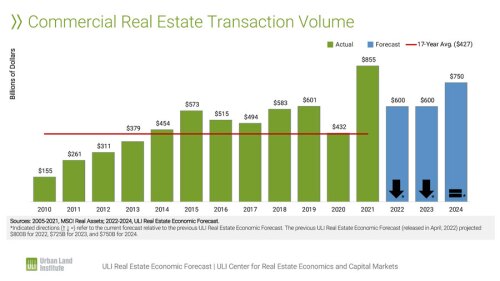
ULI Indiana recently held a networking event and tour of Cummins Indianapolis Distribution Headquarters (left) and 360 Market Square (center), two significant projects located in the redeveloping Market East area in downtown Indianapolis. Internationally recognized design firm Deborah Berke Partners led the Cummins project, with RATIO acting as executive architect. The 360 Market Square project was designed by CallisonRTKL and developed by Flaherty & Collins Properties. (Courtesy of Flaherty & Collins Properties)
With more than $3.6 billion in investment taking place in its downtown alone, Indianapolis has been on the radar of many out-of-state investors. At a recent ULI Indiana program, a panel of national owners and brokers representing office and multifamily developments shared the investment appeal of secondary cities like Indianapolis.
“In the Midwest market, some cities have evolved and accelerated more than others,” said Jim Postweiler, managing director of capital markets at JLL in Chicago. “We have to sell first-time buyers on the city first and why they should go there. For places like Indianapolis and Kansas City, when we show tangible data—a healthy tax plan, the economic climate—we can tell the story and show the patterns. A lot of groups are paying attention and realizing how healthy it has been, and that there’s room to grow.”
“As we saw in the most recent Emerging Trends in Real Estate® report by the Urban Land Institute and PwC, smaller and secondary markets are on the rise, with Salt Lake City and Fort Lauderdale working their way into the top ten,” said panel moderator Traci Kapsalis, senior vice president of Agency Leasing, Investor Services, JLL, Indianapolis. “The stories we heard during this discussion and continue to hear throughout Indy prove that this is happening in the Midwest as well, garnering the attention of investors from around the country.”
George Tikijian III, senior managing director, Tikijian Associates Multihousing Investment Advisors in Indianapolis, said that “people are coming from competitive cities looking for higher yields and actual cash flow—[Indianapolis] has more stability, creating cash flow on day one, and the pricing is appealing.” He also noted that Indianapolis and other relatively newer cities hold the promise of big purchases. “If someone is coming from far away, they don’t want to just buy a single 200-unit property; they want to accumulate a larger portfolio,” Tikijian said.
Tikijian also pointed out the “no drama” appeal of Indianapolis. “Over the past 20 years, for the most part it has risen slow and steady—there weren’t many valleys,” he said. “In addition, over the past 30 years, you don’t see any declines in average apartment rent. That slow and steady growth with higher yields is what people are looking for.”
Panelists also noted that secondary markets are seeing more institutional buyers looking for those higher yields, and in some markets like Nashville, it can be tough to pick up high-quality assets.

Fishers, Indiana, a suburb of Indianapolis, is gaining attention for its focus on economic development and placemaking. For example, the Municipal Complex Redevelopment—which won first place in the real estate redevelopment category (sanctioned by ULI Indiana) at the Indy Chamber’s Monumental Awards last year—is the result of a public/private partnership that introduces 344 apartment units, over 27,000 square feet (2,500 sq m) of retail, public parking spaces, and dynamic public green space into the heart of the growing city. The project’s designers included Context Design, CSO Architects, and DKGR Architects, and the developers included Flaherty & Collins and Loftus Robinson. (Daniel Showalter/Flaherty & Collins Properties)
“We came to Indy after putting together a list of markets we were interested in purchasing in, and there were certain parameters we needed—an MSA [Metropolitan Statistical Area] of at least 1 million, a diversified economy, good civic leadership, and a good story,” said Andy Ridley, asset manager, Square Deal Investment Management, based in Oklahoma City. “As part of our due diligence, we flew in, got a hotel room, and started walking around downtown. It immediately felt a little bit like home, but on a larger scale. From the Uber ride to the individuals we approached around the city, one of the first things we noticed was the people.”
Ridley noted that in Oklahoma City, “people smile at you on the sidewalk”—a similar occurrence in Indianapolis. Compared with some of Indianapolis’s peer cities further west, Indianapolis does not have oil and gas industries, which can affect the pricing volatility of projects.
“After we felt comfortable with the market, the typical fundamentals we explore to underwrite a market looked really good to us, from industries driving this economy to the demographics,” Ridley said. “It’s fun to see the tech and younger, more vibrant industries seeming to take off in Indianapolis.”
With their focus on development and placemaking, the suburbs of Indianapolis are gaining attention and providing provide lessons learned for other communities. “Towns around Indiana are looking at suburbs like Fishers and Carmel and saying, ‘We want to do that,’” said Tikijian. “They’re pushing to upgrade their downtowns and offering incentives to developers.”
Detractors: Perceptions and Priorities
With all the benefits cities like Indianapolis offer to investors, the pace of a market’s growth can be a strength to one investor and a weakness to another.

From left to right: moderator Traci Kapsalis, senior vice president of agency leasing, investor services, JLL; George Tikijian III, senior managing director, Tikijian Associates – Multihousing Investment Advisors; Andy Ridley, asset manager, Square Deal Investment Management; and Jim Postweiler, managing director, capital markets, JLL, speaking at a ULI Indiana event in Indianapolis.
“Our firm is comfortable with Indy and some of the other secondary and tertiary markets because of the slow, steady growth, but that might detract some of larger institutional players and real estate investment trusts,” said Ridley. “For us, this is a prime market and indicative of investments we want to replicate.”
“For office investors especially, they’ll have a guideline that says, I want to be in New York, San Francisco, Boston, Chicago . . . especially if you get to foreign capital,” said Postweiler.
Another potential detractor for investment is the perception that Indianapolis is not supply constrained. Tikijian also said investors from primary markets might feel that secondary cities do not have as much liquidity. “In Indy, the rental market is actually pretty strong, because we’re building a lot of apartments in concentrated areas like downtown or Hamilton County, where there is strong growth and absorption.”
Noting there could be a “black swan” event—an unforeseen occurrence—that disrupts the industry, panelists touched on trends that could change the face of real estate development in cities of all sizes, including rising interest rates and construction costs, lower birth rates, reduced immigration, and the rise of telecommuting with more remote workers.


